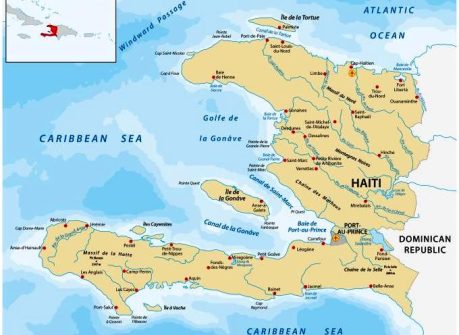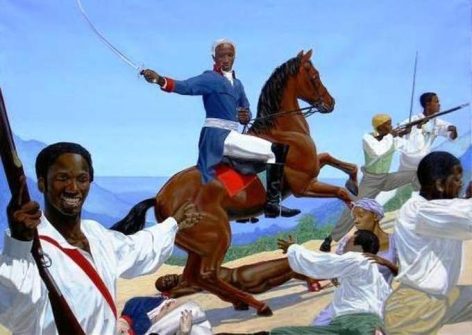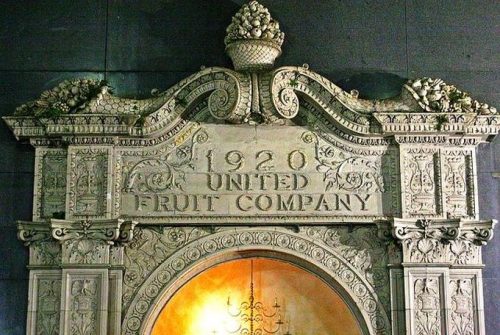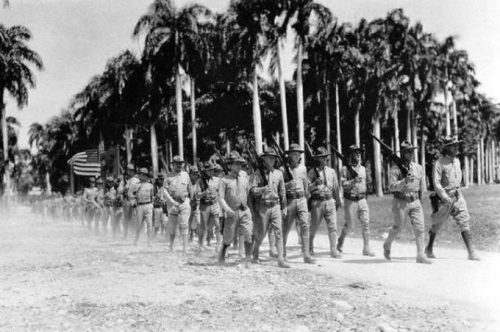Haiti in the abyss.

It is the poorest and most unfortunate country in Latin America. Countless robberies and political and natural disasters have characterized its existence. Today the country is dominated by extreme violence, corruption and a political crisis. We retrace the painful journey of a people who in history were the precursors of anti-slavery and anti-colonialist struggles throughout the region.
In the precious Caribbean Basin, within the Antilles archipelago, lies the small Republic of Haiti, a country made up of two peninsulas whose total extension is just 27,750 km2 and which occupies the western part of the island of Hispaniola, bordering to the east with the Dominican Republic.
Its predominantly mountainous territory – made up of two mountain ranges between which a smaller chain is interspersed – is home to a population of 10,033,000 inhabitants, of which 95% are of African origin while the remainder are white or mixed-race.

Map: 123rf
Known as one of the poorest and most unfortunate countries on the entire continent due to the countless robberies and disasters it has had to endure throughout its existence, Haiti is also renowned for the creativity of its artists and for having been the precursor country of antislavery and anticolonialism throughout the region, the latter an aspect which made the colonial states of the 19th century perceive it as a dangerous threat. In fact, the country, from being a flourishing Spanish and French colony to which thousands of slaves were deported to be used in the cultivation of sugar cane to replace the natives who had become extinct due to the oppression practised by Spanish slavers, was the second American Republic after the United States to declare its independence in 1804, as well as the world’s first black republic.

General Toussaint Louverture. He is known as one of the “Fathers of Haiti”. The New York Public Library.
This independence, which can also be attributed to the high organizational capacity of its people, led it in the following years to side with the liberator Simon Bolivar, using men, money and armaments, in the campaign for the emancipation of South America from the North. For this reason, Bolivar spoke out by saying “Americans from the South owe a lot to Haitians for supporting the emancipatory process”. These were, in the opinion of many historians, the reasons that caused France, England, Spain and the United States to condemn and rein in the country which now represented a real threat within the sub-continent whose main economic driving force was represented precisely by slavery. In this regard, the phrase uttered by the then American president Thomas Jefferson according to which “Haiti is a bad example” was lapidary. This concern did not appear far-fetched in light of the geographical position which makes Haiti, like other Central American and Caribbean countries, a sort of “hinge state” between South and North America. There is no doubt, in fact, that its very geographical position has conditioned the country, condemning it to continuous economic instability, a prelude to unspeakable and unstoppable social dramas.
As proof of this, we only have to remember that in the so-called “hinge states”, between the end of the nineteenth century and the beginning of the twentieth century, the major and decisive battles for the conquest of strategic, economic and financial spaces were fought between the European powers and the United States.
The United States, in particular, intervening heavily and militarily in local political life, worked to oust the European powers by virtue of the presence of substantial investments, concentrated in the production and export of agricultural tropical products, especially bananas. The consistency and importance of this capital were such as to severely limit national sovereignty. Hence the epithet “Banana Republic”.

The façade of the old United Fruit Building. New Orleans, Louisiana. Photo: Infrogmation
These were the years of the UFCO (United Fruit Company) better known as the “Green Octopus” which, due to its way of acting and its excessive business behaviour, had created a very powerful economic empire throughout the Central American and Caribbean region. Practically a sort of State within the States with police power in the territories it owns, controlling strategic sectors such as the local railway networks existing in the host country, the ports, the merchant navy, the most important banks, telephony and radio broadcasters, as well as the public procurement sector. Regarding the latter, particular attention was paid to the railway sector and the construction of railways which often served as a trailblazer for the penetration into Central American and Caribbean territories for the acquisition of new plantations.
Finally, if we consider that the budgets of this company, or of its counterparts, were higher than the state budgets of the countries where they operated, we can understand the capacity for pressure and conditioning that the governments of that area were forced to undergo. The action implemented by these companies was the result of a well-defined strategy designed by the Washington government, today known as “dollar diplomacy”, aimed at developing an intense policy of promoting and expanding financial influence in the Caribbean Basin and Central America through considerable government support for US entrepreneurs. Dollar diplomacy, however, was absolutely no alternative to the use of more brutal pressure or even of force itself.
In fact, it can easily be argued that economic strategy and repressive strategy went side by side and overlapped. It must be said, however, that in both cases these operations were masked by the American civilizing and charitable purpose aimed, at least officially, at adjusting the imbalances in local finances.

The American Soldiers arrived in Haiti in 1915. File Archive.
This vision grew immeasurably under the presidency of Wilson who, demonstrating a blind and boundless faith in the democratic and constitutional mechanisms of the US system, nourished an ethical and paternalistic vision towards Latin American governments which led him to use force and the sending of marines in the face of the rise of unconstitutional governments according to Washington’s parameters.
The logic just described is the one that pushed Washington to intervene in Haiti in 1915, to quell the popular uprisings that led to the overthrow of the government in office. Under the pretext of defending the interests of US citizens present on the island, American troops continued to station themselves in the country for a further eighteen years after the restoration of stability. Thus, under the pressure of the military occupation, Haiti was forced to sign an agreement whose duration was set at ten years, by which the appointments of the financial consultant, the person in charge of health control, as well as than that of public works were reserved to the United States. The Caribbean country also undertook in consideration of the occupier, not to cede portions of territory to other foreign powers and not to sign treaties that could “compromise independence”. Also in that period, a constitution strongly inspired by the US government was launched. In other words, despite the absence of official status, the country was effectively transformed into a protectorate of the United States. (Open Photo : Daniel Morel)
F. R.



